Leaf Walking
Leaf walking
autumnal being
rustled pace
visceral
Leaf walking
autumnal being
rustled pace
visceral
Rotating and kneeling, flow and pause, the intentions of the pilgrims immerse and emanate in this prayerful event: performing the Penitential Beds on Lough Derg.* The movements, gestures and bare feet call out in silence, a scene of activity, harmony and stillness.
One of the aspects I find most appealing are the patterns of movements. Rotations around and within each bed continually being performed and punctuated by pauses. This beautiful, unfolding scene is an ongoing prayer. A prayer that continues every day throughout the summer.
A certain reassurance radiates from these events, reminding me that all through the pilgrimage season (1st June-15th Aug) there are pilgrims praying on Lough Derg. Praying for personal intentions but also more universal themes of peace, well-being and hope. They are praying for me, for you, for us all. While I go about my daily life there are people praying the beds, as I eat they are fasting and every night as I go to bed, I think of those pilgrims preparing to undertake their Vigil. On a small lake island in Donegal, while we rest, they keep Vigil.
* This short video clip of pilgrims on the beds, taken from the roof of the male dorms and enhanced through a Vimeo filter, captures some of the unique character of St Patrick’s Purgatory.
‘Doing the Rounds’: Pattern Days at Holy Wells
This is a collection of short clips of pilgrims completing the rounds at different holy wells. It captures some of the movements and circumambulations that occur as part of the annual Pattern Day at these places. The completion of the practices continues established traditions in honour of a patron saint, while also ensuring that the site remains an active devotional space.
Featured in the video: St Gobnait’s Well Ballyvourney, Co. Cork, 11th Feb 2013; (2.01) St Fanahan’s Well, Mitchelstown, Co. Cork, 25th Nov 2012; (2.34) ‘The City’, or Cathair Crobh Dearg, Shrone, Co. Kerry 1st May 2013; (5.29) St Brigid’s Well, Liscannor, Co Clare, 1st Feb 2013.
Last week Vickie Langan (artist, soundy person and all round lady) and I visited two holy wells, The City, near Rathmore, Kerry and Tubrid, Millstreet, Cork. Below are a number of photos, videos and audio recordings, punctuated with text, that came out of the excursion. I also have a post on Researching with your Smartphone, based on our previous excursion.
This photo of the well, which was posted while we were on site, shows the cement structure along with a cup and glass. Unlike many other wells, the one at the City is not adorned with many votive offerings or extra materials. Like the site itself, it has a certain rawness. On a wind swept Tuesday in February, with the threat of serious rain, we had the places to ourselves.
Using the Soundcloud App on my phone, I took several recordings of the cup in the water, you can hear me lifting it, submerging it, pouring out some water and replacing it. This simple activity is central to these wells.
Vicky with her hydrophone, a superb piece of equipment for working with wells.
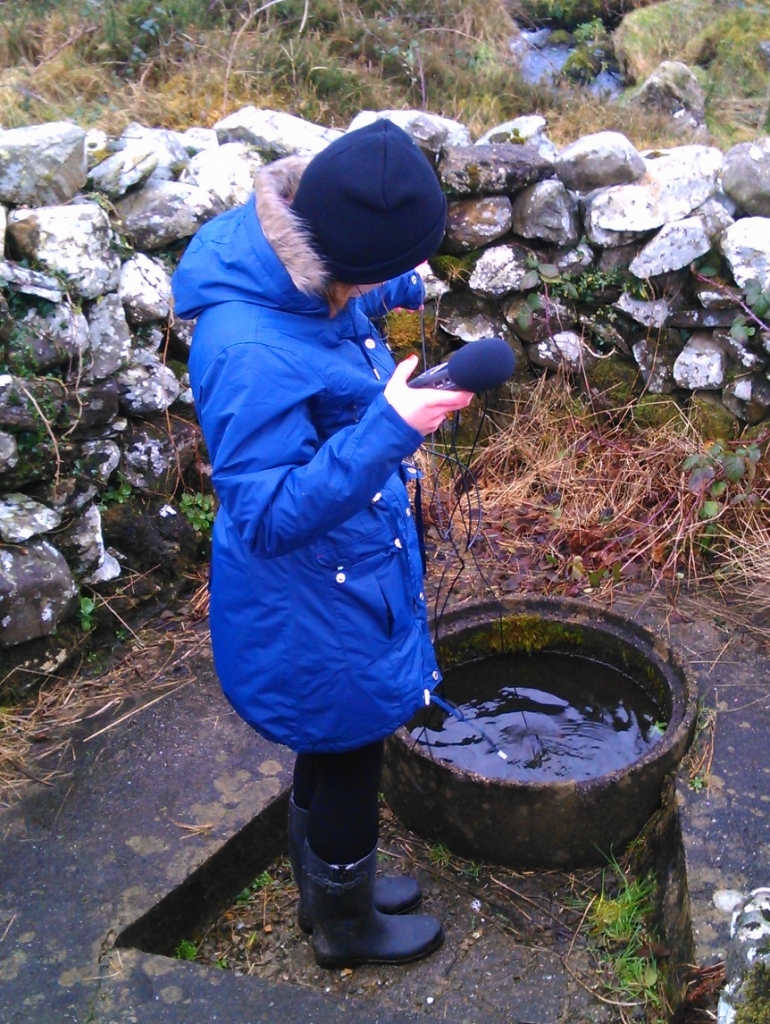
The altar at Tubrid holy well, on the Rathmore side of Millstreet. The altar is sheltered by a structure with offerings, signs and memorial cards throughout.
This short video of the candles on the altar indicate the recent visits by numerous people that day. Each one serving as an elemental remnant of a believer’s intentions and memories.
The site is very well maintained, as is demonstrated by this rack made especially to hold the cups used to drink the water and the other structures. It is at this point, where the water bubbling up in the well flows out, that people collect and drink the water.
Another recording using the SoundCloud App, of the water flowing.
The water gently emerging in a roadside holy well in Gortnacullia, Co. Galway. There is a particular peacefulness to this well, a sense of which is conveyed in this short video clip. The shallow ripples indicating a soft flow of water and ambient sounds enrich the experience.
Site record:
GA128-055 (Archaeological Survey of Ireland, Record Details) on http://www.archaeology.ie. Posted: 10 May 2007
On a recent trip to St Gobnait’s Well in Ballyvourney, I used my phone to capture some of the sounds, sights and movements of the place. The capabilities of smartphones and the selection of Apps are making it increasingly possible for all researchers, especially qualitative minded ones, to have a wonderfully versatile device with them at all times. It is now standard for a phone to be a camera, video and audio recorder, and notebook, while all the time connecting you to the internet. While the compact and multipurpose nature means that a phone does not have a quality of each of these items individually, they are a functional everyday tool which offers new potential for research, encounter and dissemination.
There also has been emerging comment on the use of phones and apps in research. Katharine Welsh and Derek France state that the “multi-tasking and portable nature of a smartphone renders the device an ideal data collection tool” and that “e educational potential offered by smartphones will likely increase over time.” (Smart Phones and Fieldwork). While Jay Zaltzman and Betsy Leichliter point out a whole range of real-time communications and recordings now possible that “can be used to share participants’ experiences and perceptions in more ways than ever” (Mobile Qualitative Research).
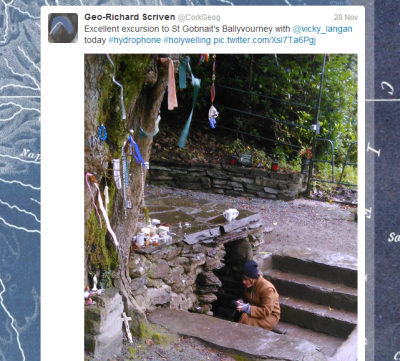
A photo taken during the fieldwork was then sent using Twitter. This serves to both record and disseminate.
Also, phones offer a means of instant dissemination as all recordings, along with micro commentary, can be immediately posted online. This also ties in with the recognition of the role of social media as a means of communicating research and engaging the public.
Here are some of the items collected and transmitted using my phone on the trip. I was able to use the phone and apps together to take photos, to make audio recordings and record video, and then transmit these using the apps.
The Soundcloud App is particularly handy as you can easily record (and pause and resume recording) edit and post the clip. This App actually captures nicely how easier apps than older tools, even using recording devices and computers together.
Instagram allows you to record, edit and upload video, while also instantly sharing the post via social media sites.
The massive leaps in technology and capabilities mean that we can only speculate on the tools that will be available for research an the potential they will over. In the meantime, get exploring and transmitting.
Sources:
Smart Phones and Fieldwork from Enhanced Fieldwork.org.uk
Mobile Qualitative Research from New Qualitative.org
Reek Sunday, the last Sunday in July, sees several thousand people climb Croagh Patrick on the southern shore of Clew Bay in Mayo. The sheer scale of the event and its links with the ancient and more modern past, mark it out as one of the most distinct events in Ireland. It is a combination of a variety of elements, including the Celtic feast of Lughnasa, Patrician lore, spiritual devotion, personal and familial tradition and the sense of an event. For a historical overview of Croagh Patrick, checkout the post from Pilgrimage in Medieval Ireland.
Although Croagh Patrick is climbed throughout the year, Reek Sunday is a special day. People from all over Ireland travel especially on that day. You are guaranteed to encounter all manner of humanity here. It is also on this day that some of the more religious or spiritual elements come to the fore. My fieldwork involved me engaging with the events, people and landscape of Croagh Patrick throughout Reek Sunday. I started off about 6am walking; however, I made frequent stops to photograph and record events. I spent a few hours on the summit taking everything in and talking to some people and, then, descended slowly, arriving down by 4pm.
This video is an amalgamation of different recordings I made throughout the day. It attempts to give a sense of the movements, sounds and moments that make up the pilgrimage.
One of the most striking aspects of the day is the significant numbers who are climbing at an early hour. While some people still practice the traditional night pilgrimage, the main crowds start arriving from about dawn. When I was walking up after 6am, there were at least several thousand people on the Reek. While most of the world rests on this Sunday morning, the approaching roads, fields being used as car parks and the paths are alive with activity. In a previous post, I have outlined the route and character of the main path leading up from Murrisk.
The steep pathway leading up the Reek proper – Casán Phádraig – is what is associated most frequently with Croagh Patrick. Pilgrims, usually with sticks, struggle up the loose surface, while those descending are moving cautiously, ever conscious of balance. On this day, the path is a stream of activity with hundreds of feet, unsecured stones, encounters and conversations. This audio secording gives as sense of how much is actually going on and how active the path is
The summit is the site of masses all morning with pilgrims gathering on the gable end of the Chapel from where the mass is celebrated; confessions are also available. While acting as a central point of the pilgrimage as a Catholic event, it is also related to the Plenary Indulgence associated with Croagh Patrick. Rounds of the chapel and St Patrick’s bed are practised, with each been circled by pilgrims saying the Rosary. Many others rest, eat and often take photos of the views across Clew Bay. Also, there are usually a number of stalls selling drinks, tea and bars of chocolate (at airport prices!). There is a sense of being separate from the mundane on the mountain. The views allows a wider perspective, with many of the immediate concerns being left behind. This sense is a crucial component of the pilgrimage experience; and, although the summit is so busy there is still a feeling of being removed from everything else
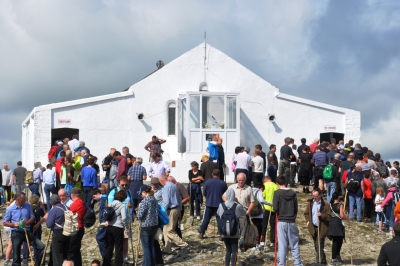
St Patrick’s Chapel on the summit, just after one of the masses (one every half hour between 8am & 2pm). Pilgrims on the left are queueing for Confessions and those on the right for Communion.
A recording of the gospel (The Beatitudes formthe Sermon on the Mount, Matthew 5:3–12) at the 9.30am mass, read by Archbishop Charles John Brown, Apostolic Nuncio to Ireland.
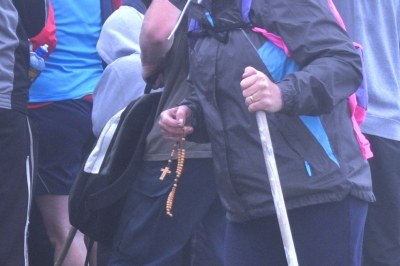
A pilgrim rounding the chapel with their rosary beads. The congregation at mass are in the background.
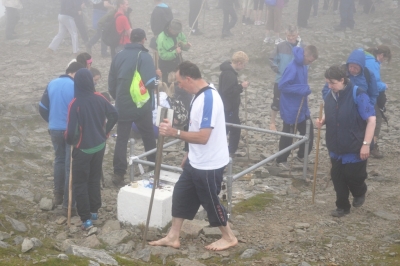
Leaba Phádraig: A number of pilgrims follow the traditional stations of the route by rounding St Patrick’s Bed reciting prayers.
Going down, which is often seen as being more challenging, involves steady footing and heavy use of the stick almost as a third foot. The mountain is known for the camaraderie it encourages in people. Those descending continually assure those coming up that there almost there, some giving slightly unrealistic estimations, possible to bolster confidence and determination. Furthermore, these seems to have been a perennial characteristic of Croagh Patrick with one 1910 commentator, known only as E O’L. writing in The Irish Monthly saying that such assurances were “well calculated to cheer and revive the drooping spirits, such as ” Bravo ! you’re getting on grand, you have only a few hundred yards more to climb,”…” (p.592).
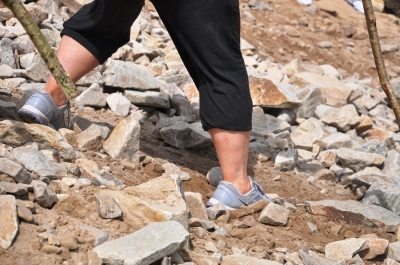
Descending the Casán: going down the steep path on uncertain surfaces is often considered to be the most challening aspect. Here the feet, the means by which the pilgrim engages physically with the mountain, are adjusting to the incline.
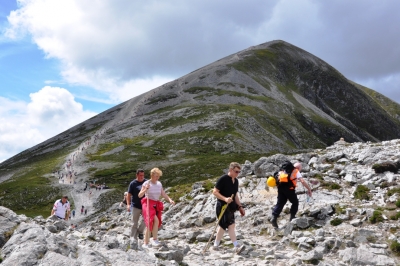
The Reek proper in the early afternoon, the steady flow of pilgrims are evident, animating the path all the way up the peak.
Further down the path one goes the more the everyday world encroaches, as everything gradually becomes closer and more real. Adding to this sensation is the collection of stalls and people at the end of the path. Whether selling or promoting something, they speak to a real world, with concerns beyond the mountain
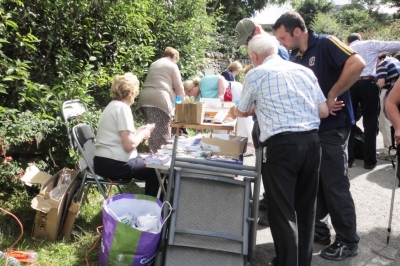
Numerous groups and business set up stalls at the base of the path in Murrisk. While, some are promotion particular causes or denominations, others are selling religious items or food.
This was my second Reek Sunday (both being motivated by my research), but I’ve already grown fond of the day. It has a distinct feel to it and I can understand some of what draws people back year after year. Also, the role played by groups such as volunteer first aiders, stewards, Gardaí, the Air Corps, clergy and local people should be acknowledged.
Suggested Reading:
Hughes, H., 2005. Croagh Patrick: Ireland’s Holy Mountain. The Croagh Patrick Archaeological Committee.
Hughes, H., 2010. Croagh Patrick: a place of pilgrimage, a place of beauty. O’Brien Pub.
O’L., E., 1910. A Pilgrimage to Croagh Patrick: July 31, 1910. The Irish Monthly, 38(448), pp.585–596.
Road to Emmaus staff, 2011. Croagh Patrick: The glorious climb of Ireland’s holy mountain. Road to Emmaus, 12(2), pp.1–45.
As part of UCC’s Doctoral Showcase – an annual event which encourages research students to develop innovative ways to communicate their research to non-specialists – I developed a short video which intends to convey a sense of place through the use of sound and images. I used a collection of audio recordings and photos from St Gobnait’s in Ballyvourney to make the video.
The showcase presentation also involved members of the audience engaging with the place tactily as well, through the distribution of rosary beads, stones form the site and water from the well; although this isn’t possible here, I feel the video still goes a long way to giving a solid glimpse at St Gobnait’s. The sounds in particular – feet crunching gravel, stone scrapping against stone, water dripping – evoke the place and what it is to be there.
P.S. I’ve previously blogged on Podcasts & Place and many thanks to my cousin Eilín for narrating the video.
St Gobnait, who is venerated at different sites in the south of Ireland, has her feast day on 11th February. St Gobnait’s house and holy well in Ballyvourney, Cork, is one of the main sites of devotion associated with the saint. On the feast day or pattern day, people come to do the rounds and visit the well. The site located just outside the village is very well maintained an attracts visitors throughout the year.
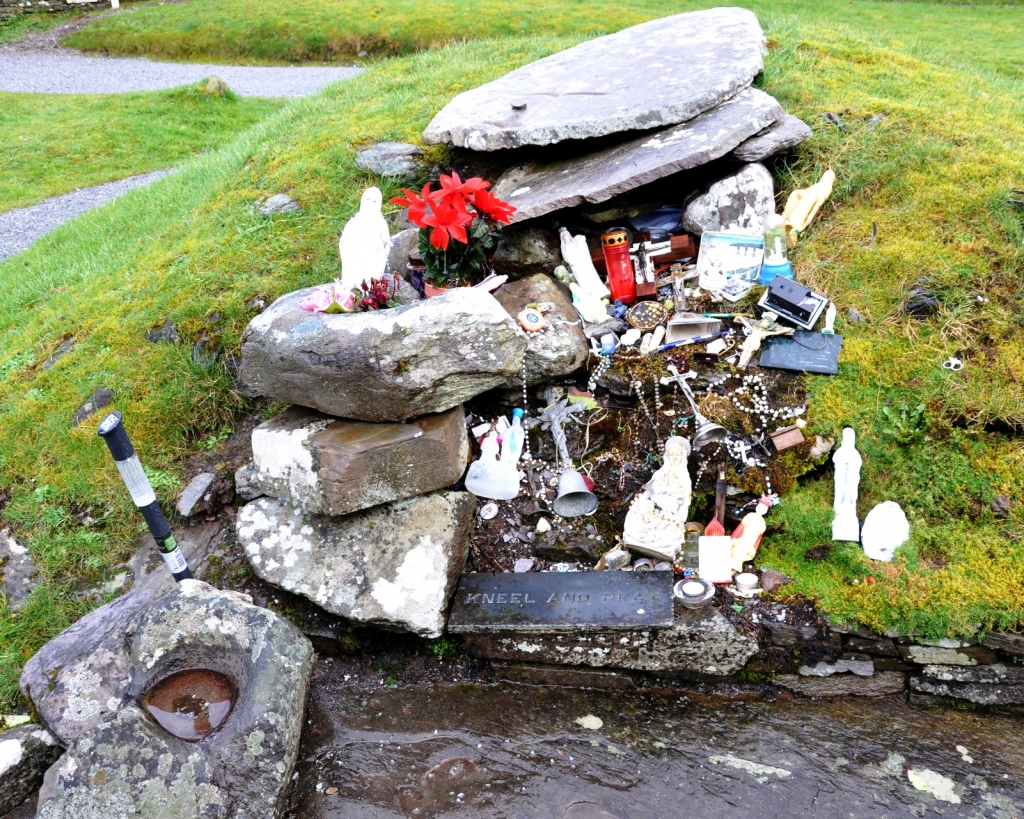
The grave of St Gobnait which is a focus of devotional activity. It is a station on the rounds and people frequently leave votive offerings here.

Looking down on the pilgrimage site from beside the statue. One of the wells is in the foreground, with the grave in the middle ground to the right and the old church, which is also part of the rounds, is in the background.
Audio Recording:
A recording at St Gobnait’s Holy Well Ballyvourney Cork on 11th Feb 2013, the feast day of the saint. The recording captures the lifting a cup form above the well, taking up some water, drinking some, returning the water, the ambient sound in the well structure and returning the cup.
Video showing the holy well:
Locating the Site:
Further reading:
Checkout Pilgrimage in Medieval Ireland‘s comprehensive blogpost on St Gobnait’s.
As part of my methodology, I am making video recordings of pilgrimage practices and events. These videos will be used alongside other records, such as my own notes and photos, to described and understand the activities I am researching. Similar to my previous comments on the use of audio recordings, I feel that video can capture a real sense of what is happening in a place, especially since my work includes a focus on the actual movements and corporealities of these performances.
My readings on qualitative research methods and the use of video, within the social sciences and the discipline of geography, have revealed several prominent themes that emerge around video as a research technique. Following a common trope in academic writing, any purposeful discussion of video mentions that the topic has been given little proper scholarly attention. However, it is still possible to identify a number of key points within the discourses, which I have briefly summarised.
The good
The not as good
Suggested reading:
Crang, M. and Cook, I. 2007. Doing Ethnographies. London: Sage.
Garrett, B.L., 2011. Videographic geographies: Using digital video for geographic research. Progress in Human Geography, 35(4), pp.521–541.
Luff, P. & Heath, C., 2012. Some “technical challenges” of video analysis: social actions, objects, material realities and the problems of perspective. Qualitative Research, 12(3), pp.255–279.
Pink, S., 2007. Walking with video. Visual Studies, 22(3), pp.240–252.
Spinney, J., 2011. A Chance to Catch a Breath: Using Mobile Video Ethnography in Cycling Research. Mobilities, 6(2), pp.161–182.